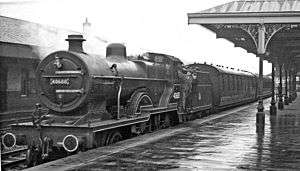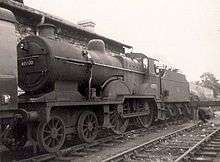LMS Class 2P 4-4-0
The London Midland and Scottish Railway Class 2P 4-4-0 was a class of steam locomotive designed for light passenger work.
| LMS Class 2P 4-4-0 | |||||||||||||||||||||||||||||||||||||||||||||||||
|---|---|---|---|---|---|---|---|---|---|---|---|---|---|---|---|---|---|---|---|---|---|---|---|---|---|---|---|---|---|---|---|---|---|---|---|---|---|---|---|---|---|---|---|---|---|---|---|---|---|
 40688 at Kilmarnock | |||||||||||||||||||||||||||||||||||||||||||||||||
| |||||||||||||||||||||||||||||||||||||||||||||||||
| |||||||||||||||||||||||||||||||||||||||||||||||||
| |||||||||||||||||||||||||||||||||||||||||||||||||
| |||||||||||||||||||||||||||||||||||||||||||||||||
Overview
The class was introduced in 1928 and was a post-grouping development of the Midland Railway 483 Class with modified dimensions and reduced boiler mountings.
The numbering continued from where the Midland engines left off at 563 and eventually reached 700. 138 were built, though numbering is slightly complicated by renumberings and transfers.
Details
| Numbers | Lot No. | Date built |
Built at | Notes | ||
|---|---|---|---|---|---|---|
| Original | 2nd | BR | ||||
| 563–571 | — | 40563–40571 | 49 | 1928 | Derby | |
| 572 | 601 | 40601 | 49 | 1928 | Derby | Experimentally fitted with Owen's double port exhaust valves from new and renumbered immediately after entering service |
| 572 | — | 40572 | 49 | 1928 | Derby | Replacement for first No. 572 |
| 573–574 | — | 40573–40574 | 49 | 1928 | Derby | |
| 575–576 | 633–634 | 40633–40634 | 49 | 1928 | Derby | Transferred to S&DJR Nos 44–45 in 1928, retaken into LMS stock 1930 |
| 575–576 | — | 40575–40576 | 67 | 1929 | Derby | Replacement for engines transferred to S&DJR |
| 577–579 | — | 40577–40579 | 49 | 1928 | Derby | |
| 580 | 635 | 40635 | 49 | 1928 | Derby | Transferred to S&DJR No. 46 in 1928, retaken into LMS stock 1930. |
| 580 | — | 40580 | 67 | 1929 | Derby | Replacement for engine transferred to S&DJR |
| 581–600 | — | 40581–40600 | 49 | 1928 | Derby | |
| 602–612 | — | 40602–40612 | 49 | 1928 | Derby | |
| 613–628 | — | 40613–40627 | 67 | 1929 | Derby | |
| 629–632 | — | 40629–40632 | 67 | 1930 | Derby | |
| 636–660 | — | 40636–40660 | 76 | 1931 | Crewe | |
| 661–665 | — | 40661–40665 | 77 | 1931 | Derby | |
| 666–685 | — | 40666–40685 | 77 | 1932 | Derby | |
| 686–700 | — | 40686–40700 | 85 | 1932 | Crewe | |
Numbers 633 and 653 were fitted with Dabeg feedwater heater in 1933.[1] Numbers 591 and 639 were withdrawn in 1934 after being heavily damaged in an accident at Port Eglinton Junction near Cumberland Street Station, Glasgow on 6 September of the same year. After nationalisation in 1948, British Railways added 40000 to the numbers of the remaining 136 engines. Further withdrawals came between 1954 and 1962. All were scrapped.


| Year | Number in service at start of year | Number withdrawn | Locomotive numbers |
|---|---|---|---|
| 1934 | 138 | 2 | 591, 639. |
| 1954 | 136 | 1 | 40662. |
| 1957 | 135 | 1 | 40676. |
| 1959 | 134 | 43 | 40565/67–68/73/76/82/87/89–90/94/98–601/05–08/10–11/16–17/33/36/44/49/53–56/58/60/66–67/73–75/77/79–80/88/93/99. |
| 1960 | 91 | 10 | 40581/83–84/88, 40630–31/52/71/90/98. |
| 1961 | 81 | 66 | 40566/69–72/74–75/77–80/85–86/92–93/95–97, 40602–04/09/12–15/18–29/32/35/37/40–43/45/47–48/50–51/59/61/63/68–69/78/82–87/89/91–92/95. |
| 1962 | 15 | 15 | 40563–64, 40634/38/46/57/64–65/70/72/81/94/96–97, 40700. |
Models
Hornby produce a 00 gauge model based on the old Dapol (formerly Airfix) tooling which is reasonably accurate.[2] Graham Farish produced an N gauge model of the 4P 4-4-0 Compound when they were in Poole, Dorset, and the chassis for this could be modified to represent the 2P. Union Mills on the Isle of Man make a 2P in N gauge.
References
- Haresnape, Brian (February 1981) [1972]. Fowler Locomotives: A Pictorial History. Shepperton: Ian Allan. p. 97. ISBN 0-7110-0374-2. CX/0281.
- "Model Rail Database". Model Rail Database. Retrieved 13 September 2015.
- Rowledge, J.W.P. (1975). Engines of the LMS, built 1923–51. Oxford: Oxford Publishing Company. ISBN 0-902888-59-5.
- "Report on the Accident at Port Eglinton Junction on 6th September 1934". Railways Archive. Retrieved 22 April 2012.